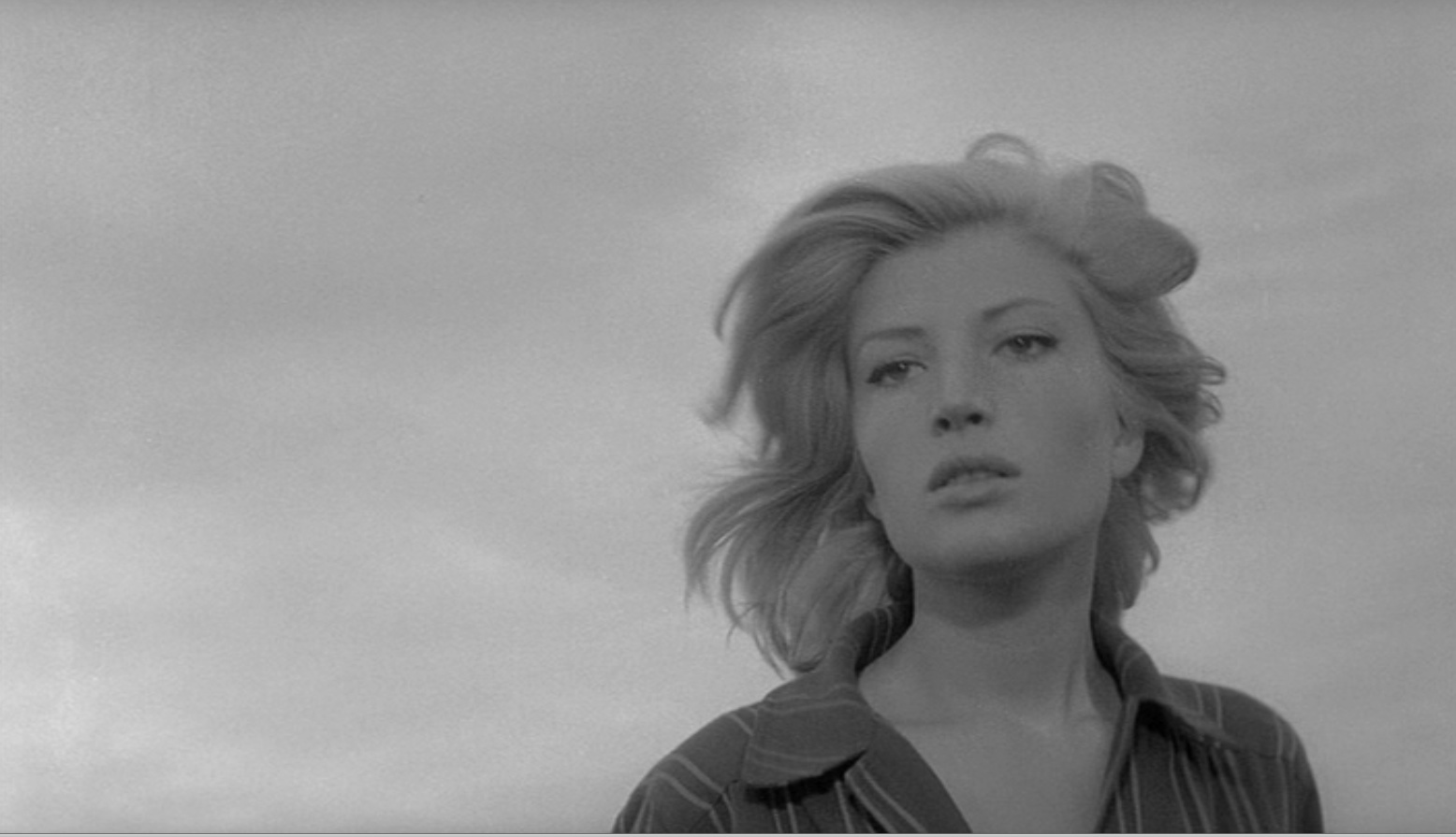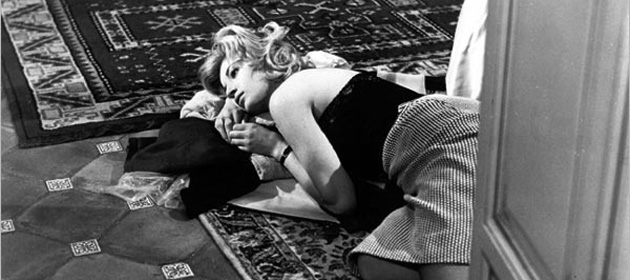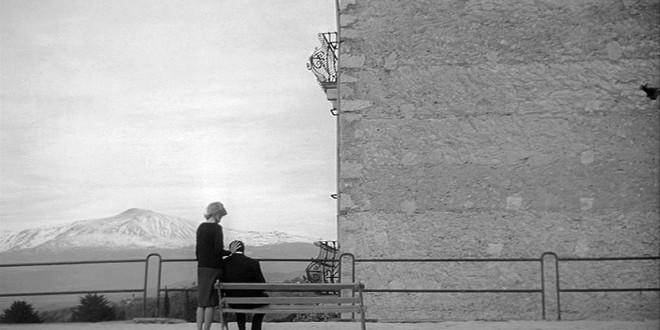
Capture the wind
It’s there as Monica Vitti opens a slighted window shutter on a dilapidated shack on the Aeolian Islands in L’Avventura, his 1960 showpiece. It’s there again for Vitti in 1961’s intellectually stultifying La Notte just as it’s there for David Hemmings’ morally misplaced fashion photographer in Blowup (1966).
It’s a frequently made halcyon vestige of Michelangelo Antonioni’s, found throughout his work, and it’s the first thing I think of when I reflect upon his considerable body of work, his hallmark, and it’s this: the wind. Was there ever a lonelier, more forsaken sound in all of cinema than the bleak, often desolate, zephyr-like shrill of wind in an Antonioni film? As it rustles through tall branches, sways and oppresses the nimbly framed vistas of his imagined worlds, it’s the endless gasping for air of the 20th century.
My introduction to Antonioni was his modernist classic, L’Avventura, and I’ve never forgotten it. Nor have I forgotten Vitti, whose troubled polish and strange grace, particularly in this film, would send me searching to see her every role, transfixed by her seeming sorcery. Antonioni and Vitti’s association would allow for great art and exploits, a towering cinematic pairing, rivalled perhaps only by the likes of Josef von Sternberg and Marlene Dietrich or Ingmar Bergman with Liv Ullmann.
L’Avventura wasn’t Vitti’s first film with Antonioni (that was a supporting role in 1957’s Teatro Nuovo di Milano) but it was her first lead, and chef d’oeuvres such as L’Eclisse (The Eclipse, 1962) and Deserto Rosso (Red Desert, 1964) would soon follow.
So, Antonioni would find his muse, a perfect foil for L’Avventura’s at times aloof, mean-spirited even, alteration on alienation and existential dread. Even after 53 years this film feels avant-garde, breathlessly awaiting the rest of us to catch up to it. And perhaps we never will.
“When I first saw L’Avventura, I was shaken. I felt just like Monica Vitti in the film. Like her, I could say: ‘I don’t know what to do… I think I have an idea… I have forgotten it already…’”
– Pedro Almodóvar
Longview

L’Avventura begins with a Anna (Lea Massari) and her friend, Claudia (Monica Vitti) in a villa outside of Rome. Aldo Scavarda’s lensing, it must be said, captures in monochrome magnificence a Mediterranean landscape that’s part hallucinatory head trip and part lyrical landscape.
Anna and Claudia are soon accompanying a circle of friends that includes Anna’s beau, Sandro (a brilliant and coldly bellicose Gabriel Ferzetti) and it becomes readily apparent that this film is neo-realism for the affluent café society. Once aboard a yacht the group set a course for Lisca Bianca, a tiny island, chic to frequent, hence they shall. No other reason is at all necessary.
The characters, particularly Anna, who is our heroine at this point, seem spiritually impoverished and morally bankrupt. Their chilly cognizance of themselves and one another is galling, at first, and this is precisely the point.
“Why should we be here talking, arguing? Believe me Anna, words are becoming less and less necessary; they create misunderstandings.”
– Sandro (Gabriele Ferzetti)
Such exchanges abound in L’Avventura and while at once poetic and charged with erotic possibility, the inherent upscale despair confounded audiences on its initial release. These cutting rich kids behaved so strangely, with no back story for the viewer to fall on or refer to, they’re unpredictable and impulsive etiquette, their instinctual, spur-of-the-moment meanderings, all seemed to rise from nowhere.
This, no doubt, was a contributing factor to the wavering hot-and-cold response at Cannes that year––incidentally, the film was awarded the Special Jury Prize at the 1960 Cannes Film Festival. Cannes has always been notorious for fervent and furious audience reactions.
With all due respect, these crowds have been known to boo and heckle Golden Palm winners like David Lynch’s Wild at Heart while obtusely giving Kevin Smith’s Clerks 2 a standing ovation. So please, let such ribald responses be gauged accordingly. Cannes attendees are often confused and inscrutable at best.
“At its premiere at the Cannes festival, the audience booed, but it won the Jury Prize and became a box-office success all over the world. It was the most pure and stark of several films about characters who drifted in existential limbo. In America, it came at a time when beatniks cultivated detachment, when modern jazz kept an ironic distance from melody, when it was hip to be cool. That whole time came crashing down later in the 1960s, but while it lasted, L’Avventura was its anthem.”
– Roger Ebert
The state I’m in

Antonioni, an artist of great breadth, quickly shatters the typical three-part story structure when, 25 minutes or so into the film Anna vanishes. The main character to that point, is gone without a trace, leaving her icy escorts at an impasse none of them have the internal fortitude to serve, particularly when Sandro has just as much interest in Claudia (for him an empty image of beauty and libidinous laissez-faire posturing).
As the film progresses, wearing its slow-pacing and deliberate languor like jaded jewellery, Claudia and Sandrot’s lukewarm pursuit of Anna becomes an abortive effort of wheel-spinning idle. Ennui in overdrive, Ferzetti and Vitti exemplify the idea that the modern world is unable to pay attention for too long. There’s becomes a search without substance, one that cannot connect or coalesce, a mystery that is never to be happy let alone licked.
Claudia: Tell me you love me.
Sandro: I love you.
Claudia: Tell me you don’t love me.
Sandro: I don’t love you.
1960 saw L’Avventura released alongside such synchronous films as Federico Fellini’s La Dolce Vita––also capturing the zeitgeist entwined in a byzantine quest of emptiness––and Alfred Hitchcock’s Psycho––who also saw its protagonist exit before the 2nd act, leaving the audiences devotions dovetailed. René Clément’s tormenting Purple Noon and Bergman’s obliterating The Virgin Spring also helped underscore that something pragmatic was certainly and quite literally in the water. L’Avventura, I boldly assert, has aged better than all of them.
Sandra and Claudia’s search for Anna, for which they have so little to go on, is evened by how little their enthusiasm for such a quest would truly call for. This sterile searching, framed by Antonioni, established him as a major talent, displayed L’Avventura confidently as his breakthrough film—whose surefire satiety and ennui would carve the career paths of Jim Jarmusch (Stranger Than Paradise, The Limits of Control) and Sophia Coppola (Lost in Translation, Somewhere)—and an existential exemplar.
So painterly and precise was Antonioni’s canvas-like symmetry, the elevation of pop art to high art was settled in one fell swoop. The images of ingenious architecture and awesome nature, as in the menace of the looming Stromboli volcano, overblown, it imposes itself allegorically unto the characters and unto us. Like the cold and cruel winds we cannot ignore or clean forget, L’Avventura bays endlessly at our sides and will hound us always.
Author Bio: Shane Scott-Travis is a film critic, screenwriter, comic book author/illustrator and cineaste. Currently residing in Vancouver, Canada, Shane can often be found at the cinema, the dog park, or off in a corner someplace, paraphrasing Groucho Marx. Follow Shane on Twitter @ShaneScottravis.